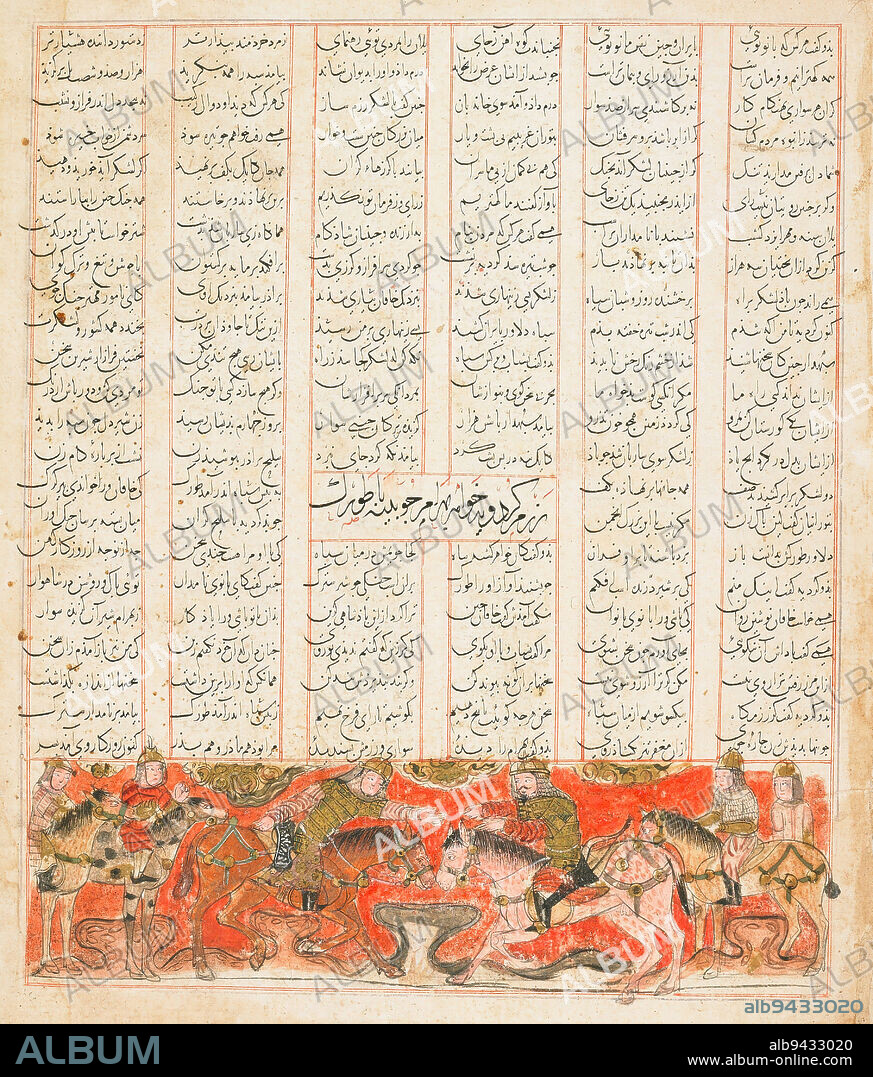alb9433020
Gordiya Parleys with Tuwurg, 1341, Hasan ibn Muhammad ibn `Ali ibn Husaini (known as al-Mausili), 13 x 8 1/8 in. (33.02 x 20.64 cm) (sheet), Ink, colors, and gold on paper, Iran, 14th century, This page, from the same Shahnameh manuscript as the work on the left, shifts the image to the bottom of the six-columned text, demonstrating the variety and visual rhythm of the complete manuscript. The scene depicts the influential Iranian noblewoman Gordiya, seen on horseback on the left. Her late brother Bahram had attempted to seize the throne from the Sasanian emperor Khosrow II (r. 590628 CE). After Bahrams defeat, they fled to the court of the emperor of China who insisted on taking Gordiyas hand in marriage. Unwilling, Gordiya plans her escape; the emperor soon learns of Gordiays intentions and sends his military leader, Tuwurg, seen on the right, to bring her back. This painting, with its freewheeling composition of polo-like combat, foreshadows Gordiyas victory over Tuwrug, and her triumphant return to Iran, where she ultimately marries Khosrow II.

|
Add to another lightbox |
|
Add to another lightbox |



Buy this image.
Select the use:

Caption:
Gordiya Parleys with Tuwurg, 1341, Hasan ibn Muhammad ibn `Ali ibn Husaini (known as al-Mausili), 13 x 8 1/8 in. (33.02 x 20.64 cm) (sheet), Ink, colors, and gold on paper, Iran, 14th century, This page, from the same Shahnameh manuscript as the work on the left, shifts the image to the bottom of the six-columned text, demonstrating the variety and visual rhythm of the complete manuscript. The scene depicts the influential Iranian noblewoman Gordiya, seen on horseback on the left. Her late brother Bahram had attempted to seize the throne from the Sasanian emperor Khosrow II (r. 590628 CE). After Bahrams defeat, they fled to the court of the emperor of China who insisted on taking Gordiyas hand in marriage. Unwilling, Gordiya plans her escape; the emperor soon learns of Gordiays intentions and sends his military leader, Tuwurg, seen on the right, to bring her back. This painting, with its freewheeling composition of polo-like combat, foreshadows Gordiyas victory over Tuwrug, and her triumphant return to Iran, where she ultimately marries Khosrow II.
Personalities:
Credit:
Album / quintlox
Releases:
Model: No - Property: No
Rights questions?
Rights questions?
Image size:
3631 x 4259 px | 44.2 MB
Print size:
30.7 x 36.1 cm | 12.1 x 14.2 in (300 dpi)
Keywords:
1341 • 14TH CENTURY • 590628 CE • AL-MAUSILI • ANT. OR.: IRAN • ATTEMPTED • BACK • BACKSIDE • BAHRAM'S DEFEAT • BOTTOM • BRING • BUTT • CHINA • CHINE • CHINESE • COLORS • COMPLETE MANUSCRIPT • COURT • DEMONSTRATING • EMPEROR SOON LEARNS • EMPEROR • ESCAPE • FLED • FORESHADOWS GORDIYA'S VICTORY • FOURTEENTH CENTURY • FREEWHEELING COMPOSITION • FURNITURE: THRONE • GOLD • GOLD, ALL • GOLDEN • GOLDSMITH • GORDIAY'S INTENTIONS • GORDIYA PARLEYS • GORDIYA PLANS • HASAN IBN MUHAMMAD IBN 'ALI IBN HUSAINI • HORSEBACK • IMAGE • INFLUENTIAL IRANIAN NOBLEWOMAN GORDIYA • INK • INSISTED • IRAN • KAISER • LATE BROTHER BAHRAM • LEFT • MARRIAGE • MATRIMONIO • MILITARY LEADER • PAGE • PAINT • PAINTING • PAINTINGS • PAPER AND PACKAGE PRODUCTS • PAPER • POLO-COMBAT • PORCELAIN • R • RIGHT • SASANIAN EMPEROR KHOSROW II • SCENE DEPICTS • SEIZE • SENDS • SHAHNAMEH MANUSCRIPT • SHEET • SHIFTS • SHOWING • SIX-COLUMNED TEXT • TAKING GORDIYA'S HAND • THRONE • TRIUMPHANT RETURN • TUWRUG • TUWURG • ULTIMATELY MARRIES KHOSROW II • UNWILLING • VARIETY • VISUAL RHYTHM • WEDDING • WORK • XIV CENTURY
 Pinterest
Pinterest Twitter
Twitter Facebook
Facebook Copy link
Copy link Email
Email
